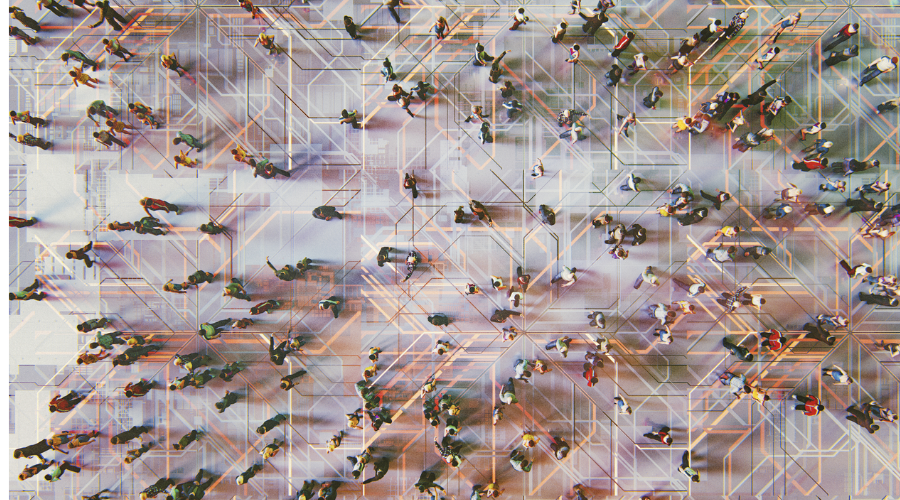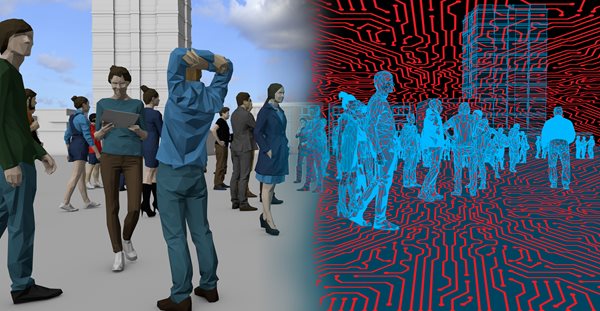
As large-scale events become increasingly common, the need for effective crowd management has become paramount. Incidents such as the Halloween stampede in South Korea in 2022 and the Astroworld Festival in 2021 underscore the critical importance of understanding and managing crowd dynamics. Leveraging innovative technologies like digital twins can enhance safety and help prevent risks in these events.
Digital twins are virtual models of physical spaces that reflect real-world behaviour and performance. To build accurate digital twins for crowd management, Artificial intelligence (AI) technologies like Generative Agent-Based Modelling (GABM) can be leveraged, forming part of AI solutions for public safety. GABM, with its large corpus of pre-trained knowledge within its Large Language Model, has the potential to augment traditional crowd simulation approaches, providing more realistic representations of crowd behaviours. Furthermore, GABM can potentially adapt to unknown situations – a capability that traditional crowd simulation techniques may lack.
One of the most significant advantages of digital twins and GABM is the ability to model and simulate potential risk scenarios before they occur. By simulating various crowd control strategies in a virtual environment, organisers can identify vulnerabilities and optimise their plans long before the event takes place. For example, GABM can simulate a sudden surge in crowd density at a music festival, allowing organisers to see how different intervention strategies might play out and which would be most effective in preventing a stampede.
GABM also plays a crucial role in training and preparedness. By immersing security personnel, event organisers, and emergency responders in realistic, simulated scenarios, GABM gives participants the confidence to act decisively when the situation arises and provides the opportunity for all parties to have hands-on training so that they are well-prepared to efficiently handle emergencies. |

During an event, digital twins can provide a live, up-to-the-minute virtual replica of the environment, enabling real-time monitoring of crowd movements and behaviours. For example, if a digital twin of an event site shows a dangerous build-up of people in a specific area, GABM can alert and recommend the most effective ways to redirect the crowd or deploy security personnel to prevent escalation.
This real-time monitoring and proactive approach to risk assessment enables swift and informed decision-making, ensuring attendee safety and well-being, and elevates the overall security of an event.
However, the successful implementation of these technologies requires strong partnerships and collaborative research efforts. Technology firms, academic institutions, government, and public safety agencies must work together to develop and refine these tools.
Partnerships aside, a significant consideration in the deployment of digital twins and agent-based simulations is the importance of handling data responsibly, respecting data privacy and adhering to stringent data protection regulations. Another consideration is the alignment to social values in the generative AI’s decision-making criteria to avoid situations such as the machine prioritising one person’s injury over a group’s safety.
Inclusion of diverse voices about the use of generative AI for public safety is especially crucial. A robust framework for the use of AI will require input from ethicists, lawmakers, community representatives and technical experts as it evolve. |
Collaboration among these groups can address technical and ethical challenges, ensuring AI-driven solutions are accurate, reliasble, and ethically responsible, aligning with the needs and values of the people they are designed to protect.
The tragedies we have witnessed during mass gatherings highlight the urgent need for modern crowd management strategies. Digital twins and GABM offer a promising path forward, representing a fundamental shift in how we approach risk management at large-scale events. If deployed thoughtfully, these technologies can become game-changing assets, unlocking the full potential of digital twins and GABM for safer and better events.
Copyright © 2025 ST Engineering
By subscribing to the mailing list, you confirm that you have read and agree with the Terms of Use and Personal Data Policy.